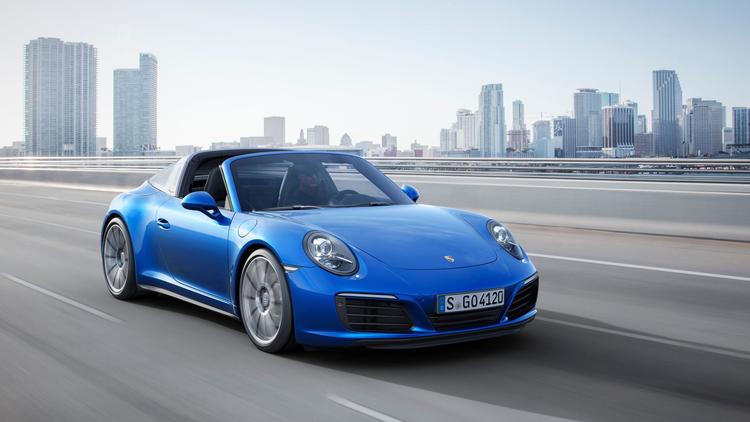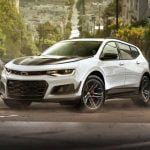ay what you will about the French Art Deco cars of the 1930s or the British sports cars of the 1960s. There has never been a better time in the automotive world than 2017.
Cars and trucks are faster, safer, more fuel efficient and more fun to drive than ever before. And there are so many to choose from.
Automotive perfection is rolling out regularly from factories all over North America, Europe and Asia. There’s practically no such thing as a bad car or a bad car company; they all have something good to offer.
But some seem particularly worthy of attention and accolades. Here are my favorite vehicles from 2017:
Porsche 911 Targa 4S
The German sports car company’s 2017 model of this delicious canyon-carver didn’t look much different from earlier versions. But under the hood and elsewhere it was significantly improved. The naturally aspirated flat-six engine has been replaced by a 3-liter, six-cylinder boxer that’s turbocharged and makes 420 horsepower and 368 pound-feet of torque. The 4S also got a sport exhaust, Sport Chrono package, GT-style steering wheel and rear axle steering — borrowed from the 911 GT3, GT3 RS and Turbo cars. For my money — well, if I had that kind of money, or a car-buying budget of $150,000 — there is no better non-exotic sports car on the road than the 911 Targa 4S, and almost no better L.A. drive than a spin up Angeles Crest in this Targa-top Porsche.
Ferrari GT4 Lusso
Car companies keep trying to build the perfect beast, the ideal auto that can be sporty around town, comfortable on the freeway and competitive at the track. Ferrari comes close with this grand touring sports car. Powered by the legitimately legendary V-12 engine, which makes a staggering 680 horsepower and 514 pound-feet of torque, the GT4 Lussohits a top speed of 208 mph and a zero-to-60 pace of under 3.4 seconds, all while encasing driver and passenger in lush luxury.
Corvette GS Coupe
I had as much fun in this Grand Sport Corvette as any car I drove in 2017, partly because it’s such a throwback. During a period in which many mega-cars are laden with the latest in four-wheel drive, four-wheel steering and magical magnetic suspension, this is still a caveman car — a front-engine, rear-wheel-drive tire-smoker fitted with a 6.2-liter V-8 engine that makes 460 horsepower and 465 pound-feet of torque. Mated to a seven-speed manual transmission, it promises zero to 60 mph in 3.6 seconds and a top speed of 181 mph. With a base price of under $70,000, it’s a sports car steal.
Tesla Model X P100D
Elon Musk started proving years ago that automotive performance need not require destroying the environment, and his Model X P100D is the safest, quickest and most sophisticated SUV ever built. At a reported 2.9 seconds from zero to 60 mph, it’ll beat almost any gas-powered vehicle currently being sold. Throw in a luxurious, space-age interior, a 289-mile all-electric range and Tesla’s poorly named but unbelievably sophisticated Autopilot, and you have the most interesting car on the road today.
Toyota C-HR
Not every car I tested this year cost more than I paid for my first house. Toyota’s intelligent, attractive C-HR was a stand-out among affordable automobiles. True, its 2-liter, four-cylinder engine, which makes 144 horsepower and 139 pound-feet of torque, did occasionally feel like it needed a few more hamsters on the wheel, but the application of that power to all four wheels, through Toyota’s CVT automatic transmission, made this a dependable compact SUV. The C-HRs start at below $23,000. What will you do with all the money you save — like those Toyota ads used to ask? Put money aside for that 911.
Jaguar F Type SVR
My favorite drive of the year was the warm August day I spent back-roading home from the Pebble Beach Concours D’Elegance. Buckled into the high-end trim version of the F Type, with the top down, I covered every curvy canyon road between Big Sur and Burbank. Seemingly recovered under the Tata-owned Jaguar Land Rover umbrella from years of “British Car Disease,” the latest F Type SVR is powered by a supercharged 5-liter V-8 engine that delivers smooth-as-silk power on a chassis made delightfully responsive by sophisticated suspension and a comfortable cabin. My only regret is the manufacturer’s suggested retail price, which tops $125,000 for the SVR model.
Kia Soul Turbo
Almost as much fun to drive as the sports cars made by Porsche and Jaguar, but a lot more affordable, is the Kia Soul Turbo. I have an admitted soft spot for square, boxy, practical cars. This one stole my heart. I liked the perky 1.6-liter, four-cylinder engine and its 201 horsepower and 195 pound-feet of torque. I liked the seven-speed dual-clutch transmission and the grabby front-wheel drive. I wish it came with a stick shift option and that it weren’t quite so noisy on the freeway. But I really enjoyed sporting around town in this smart little car. If I were 27 years old and had $27,000 to spend, this little turbo would already be in my driveway.
Honda Ridgeline
Honda’s “sport utility truck” doesn’t compare well with traditional pickups like the Ford F-150, Chevy Silverado, Ram 1500, Toyota Tacoma or Nissan Titan. But it’s a really useful light-duty vehicle for someone who likes to drive an SUV all the time and needs a truck sometimes. The Ridgeline shares its 3.5-liter V-6 engine with the Honda Pilot and sister company Acura’s MDX, as well as many of their driving characteristics. It’s easy to drive, easy to park and loaded with friendly ergonomics and accessories. I did a Death Valley drive through Titus Canyon in this truck and found it as capable up the rocky side and down the sandy side as it was comfortable on the freeway.
Lamborghini Aventador S
Lamborghini calls its flagship road racer a “super sports car.” Driven by a V-12 engine that makes 740 horsepower and 508 pound-feet of torque, the sleek, reptilian coupe is said to be capable of zero to 60 mph in less than 2.9 seconds and a top speed of 217 mph. I only drove the Aventador S on the track, and I only had it up to about a buck and a half, so I can’t speak to quotidian questions of staying comfortable in the race seats, changing lanes in heavy traffic or finding a safe place to protect this $450,000 investment. From driving other low-slung Lambos, I know that every supermarket and gas station driveway presents challenges. And at 11 miles per gallon fuel consumption in city driving, you’ll be seeing a lot of gas stations. But … what a car!
Zero DS
I spent the better part of several weeks last winter doing a lot of my daily commuting on an electric motorcycle — the Zero DS 6.5 model. A stripped-down version of the standard DS, the 6.5 makes less power and doesn’t go as far on a charge. But it also weighs 100 pounds less than its big brother, is about $3,000 cheaper and was motorcycle enough for zipping down Sunset Boulevard and lane-splitting on the 101 Freeway. Though its roughly 80 miles of battery electric range makes it impractical for rides to Wrightwood, the Zero pulled into my garage every night, connected to a standard 120-volt wall plug and was juiced and ready to go by the next morning. Research shows that by saving on fuel and reducing maintenance expenses to nearly nothing, a Zero costs substantially less to own than a gas-powered equivalent bike.
[“Source-latimes”]





